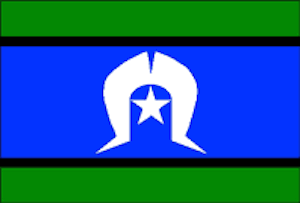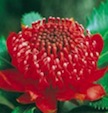The Australian National Flag flies over federal and state parliament buildings, and is carried by Australian defence forces.
The Union Jack in the upper left corner acknowledges that Australia was once a British colony.
The Australian Flag
Q. Who designed it?
A. A competition was held for a design in 1901. Five entries, almost identical, shared the prize. Artist Annie Whistler Dorrington was the first named of the five.
Q. When and where was it first flown?
A. 1901 in Melbourne. In 1908 a seventh point was added to the Commonwealth star to represent the territories.
Q. What do the stars represent?
A. The five stars on the right represent the constellation of stars known as the Southern Cross and represents Australia's location in the southern hemisphere. The large, seven pointed star is the Federation or Commonwealth star. Each of the points represents one of the six States and seventh is for the present Australian Territories (Canberra, and the Northern Territory)
Read more about the history of Australian flags:
https://www.pmc.gov.au/government/australian-national-flag
The Commonwealth Coat of Arms
The Coat of Arms is the symbol of the Commonwealth of Australia, the official badge of the Commonwealth Government. It is used by all Government departments, and is on Commonwealth Government buildings.
In 1912 the new design was approved by King George V, and is the Coat of Arms we know and use today. The shield in the centre was divided into six, each with the badge of a state. The shield and 'supporters', the kangaroo and emu, are now surrounded by golden wattle, the national floral emblem. At the bottom, the scroll simply says 'Australia'.
Read more about the Australian Coat of Arms:
https://www.pmc.gov.au/government/commonwealth-coat-arms
Australia's National Anthem: ADVANCE AUSTRALIA FAIR
Q. Who composed it?
A. Peter Dodds McCormick (1834-1916). It was first performed in 1878 as a patriotic song.
Q. When did it become the national anthem?
A. 1984 after a majority of Australian citizens voted for it in a national plebiscite (vote) to choose from several songs, including the choice of keeping God Save the Queen.
Listen to the the National Anthem:
ADVANCE AUSTRALIA FAIR
Australians all let us rejoice,
For we are young and free;
We've golden soil and wealth for toil;
Our home is girt by sea;
Our land abounds in nature's gifts
Of beauty rich and rare;
In history's page, let every stage
Advance Australia Fair.
In joyful strains then let us sing,
Advance Australia Fair.
Beneath our radiant Southern Cross
We'll toil with hearts and hands;
To make this Commonwealth of ours
Renowned of all the lands;
For those who've come across the seas
We've boundless plains to share;
With courage let us all combine
To Advance Australia Fair.
In joyful strains then let us sing,
Advance Australia Fair.
The Aboriginal Flag
The Aboriginal peoples, the original inhabitants of the continent, have lived here continuously for over 50 000 years.
In 1971 a flag to represent Aboriginal peoples was designed by Harold Thomas. The Aboriginal flag is divided in two: the top half is black, symbolising Aboriginal peoples, the red half represents the red earth, the golden circle is the sun, the source of renewal of life.
In 1992 a flag representing the Torres Strait Islander peoples was designed by the late Bernard Namok, from Thursday Island.
The colour green is for the land.
The dharri or deri headress is a symbol for all Torres Strait Islanders.
The black represents the people.
The blue is for the sea.
The five-pointed star represents the island groups. Used in navigation, the star is also an important symbol for the sea-faring Torres Strait Islander people.
The colour white of the star represents peace.
Watch a video about Australia’s Aboriginal flags
https://www.youtube.com/watch?v=7dyybimiRBw
Read about the creator of the Aboriginal flag, Harold Thomas:
https://www.haroldthomasart.com.au/harold-thomas-art-2/
Australia's Floral and Faunal Emblems
Golden wattle. Image©Getty
Australia's floral emblem is the golden wattle, animal emblem is the red kangaroo and bird emblem is the emu.
Each of these is unique to Australia, and are represented on our Coat of Arms.
State and Territory emblems of Australia
Each Australian state and territory also has a flower, an animal and bird emblem. Some have a marine or gemstone emblem as well. These represent the state because they originate there, are found only there or are exceptionally noted there.
They are:
Australian Capital Territory: royal bluebell, no animal emblem, gang-gang cockatoo
New South Wales: waratah, platypus, kookaburra
Victoria: pink heath, Leadbeater's possum, helmeted honeyeater
Tasmania: bluegum, Tasmanian devil, yellow wattlebird (unofficial)
South Australia: Sturt desert pea, southern hairy-nosed wombat, leafy sea dragon
Western Australia: kangaroo paw, numbat, black swan
Northern Territory: desert rose, red kangaroo, wedge-tailed eagle
Queensland: Cooktown orchid, koala, brolga.
Read about the floral emblems of the Commonwealth of Australia and of each state and mainland territory:
http://www.australia.gov.au/about-australia/facts-and-figures/national-symbols
Read about the state faunal emblems, animals and birds:
http://www.australiangeographic.com.au/topics/wildlife/2014/08/australias-animal-fauna-emblems















